In warm, humid, beautifully green Budapest, I stroll along the Danube before approaching 19th century interior of the lovely old Gerbeaud, a destination cafe and pastry shop in the heart of old town Budapest.
Here along with a juicy variety of mostly ladies who lunch, but the occasional Italian man, or table of German students with backpacks, I selected an opulent pastry from a display case of cakes, tortes, and strudels capable of inducing diabetes right on the spot. The interior, with its dark wood, chandeliers, and tall windows is straight out of Florence circa 1890.
The pastry looked like a Disney movie, but incredibly enough it was actually wonderful. Like a hyper-creamy cheesecake built on top of a disk of pastry crust with apricot puree embedded inside. Along with the world’s tiniest espresso, I ate almost the entire million calorie delight.

Nearby, along the pedestrian corridor with its herringbone and checkerboard walkways of cobblestones, were a handful of lively cafes including Anna Cafe, a place filled with locals and visitors from all over the world—mostly America, France, and Germany—all clamoring for beer, ice cream, and some of those slow-cooked Hungarian specialties.
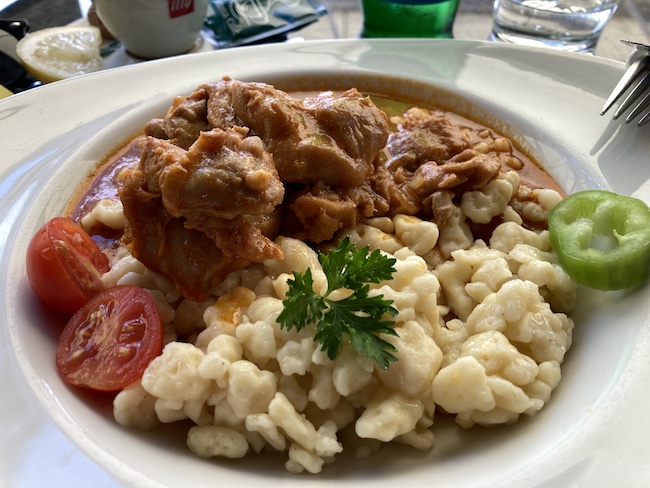 I too succumbed to an irresistible Chicken Paprikish with galuszkaval….little noodlelike dumplings. The dish arrived steaming hot, utterly delicious. Homey chicken stew liberally perfumed with paprika, and the noodles were the ultimate comfort food. The temperature in the shade was at least 85 degrees so my lunch was consumed with a large bottle of mineral water. The couple to my right worked their way through enormous bowls of ice cream, sauced with chocolate and fruit, and topped with whipped cream. Bowls the size of children’s wading pools. They finished everything.
I too succumbed to an irresistible Chicken Paprikish with galuszkaval….little noodlelike dumplings. The dish arrived steaming hot, utterly delicious. Homey chicken stew liberally perfumed with paprika, and the noodles were the ultimate comfort food. The temperature in the shade was at least 85 degrees so my lunch was consumed with a large bottle of mineral water. The couple to my right worked their way through enormous bowls of ice cream, sauced with chocolate and fruit, and topped with whipped cream. Bowls the size of children’s wading pools. They finished everything.
On my first evening in Budapest—the only one in which I would not be sitting in a long opera—I went downstairs to my hotel restaurant, which happened to have a Michelin star. Costes Downtown is sleek, minimalist, and smartly run by young staffers who speak excellent English. My fellow diners were from France, Germany, and England. [English was the default language everywhere in Budapest. Good thing, since Hungarian is known for being among the most difficult languages in the world, second only to Finnish.]
I tell the hostess I can’t possibly consume the eight (8) courses of the prix fixe dinner, so she smartly consults with the kitchen and offers me the four course lunch menu instead. Eager to sample the non-Tokay Hungarian wines, I opt for the wine pairing to go with the meal.
 The courses, all wonderful, begin with delightful amuses. A warm kumquat arrives filled with pureed kumquat. A granita of citrus and Campari comes topped with carrot foam. A baby green leaf is flash fried. The bread is so good I could cry. An oat-based ciabatta, it arrives with a fist full of soft French butter that has been oak-smoked and topped with (so help me) Hawaiian charcoal. The effect is of a hint of smoke and intensely mineral/salt finish. This is bread that can actually hold its own with my fresh memories of French baguettes.
The courses, all wonderful, begin with delightful amuses. A warm kumquat arrives filled with pureed kumquat. A granita of citrus and Campari comes topped with carrot foam. A baby green leaf is flash fried. The bread is so good I could cry. An oat-based ciabatta, it arrives with a fist full of soft French butter that has been oak-smoked and topped with (so help me) Hawaiian charcoal. The effect is of a hint of smoke and intensely mineral/salt finish. This is bread that can actually hold its own with my fresh memories of French baguettes.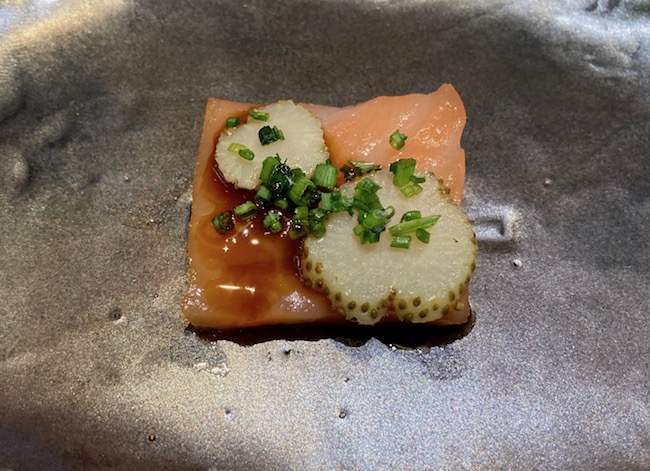
Next comes a square of house cured salmon topped with the surprise of sliced green strawberries and a glaze of ponzu sauce. Flavors that are fabulous together, yet who does such a pairing? I’m beginning to sense the chef’s modus operandi. The first wine arrives, a single vineyard white with a slight effervescence, salt and stone in the beginning, a fresh finish. Every dish that arrives comes on a different kind of plate or platform, from a slice of agate, to a marble bowl, to glazed stoneware, to porcelain. Wonderful.
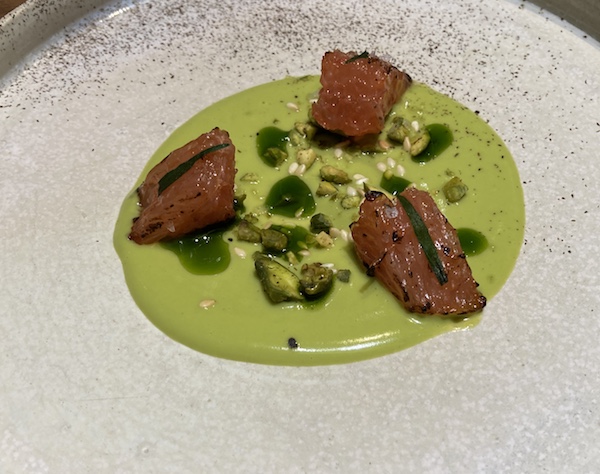 Another starter of grapefruit, with fresh tarragon on a shallow lake of pistachio cream is a surprise and a knock-out.
Another starter of grapefruit, with fresh tarragon on a shallow lake of pistachio cream is a surprise and a knock-out.
The second white wine has the sweet nose of botrytis, but a crisp finish to go with a dish of lightly cured rainbow trout with dashi and blackberries. The chef spent time in Vietnam and Tokyo, as well as in the kitchen of Ferran Adria, all of which inflects his tendency toward Asian accents.
 The main course of aged Hungarian beef is served with a splendid cabernet franc offering ample tannins. A little salad on the side is topped with glistening salmon caviar and cornichons. The surrounding sauce is bright with citrus, chiles, sesame, truffle foam and roast potatoes.
The main course of aged Hungarian beef is served with a splendid cabernet franc offering ample tannins. A little salad on the side is topped with glistening salmon caviar and cornichons. The surrounding sauce is bright with citrus, chiles, sesame, truffle foam and roast potatoes.
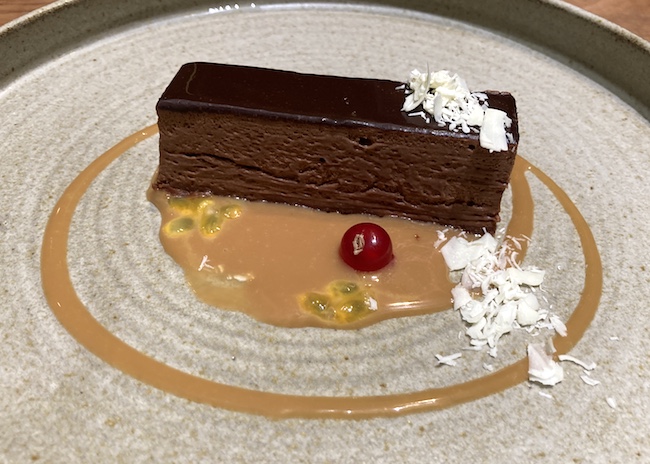 Dessert is chocolate mousse with hazelnuts and a passionfruit caramel sauce. Dreamy is the word that comes to mind. After an espresso—why not live on the wild side?—I take a glass of Fernet Branca up to my room. And sleep very well.
Dessert is chocolate mousse with hazelnuts and a passionfruit caramel sauce. Dreamy is the word that comes to mind. After an espresso—why not live on the wild side?—I take a glass of Fernet Branca up to my room. And sleep very well.

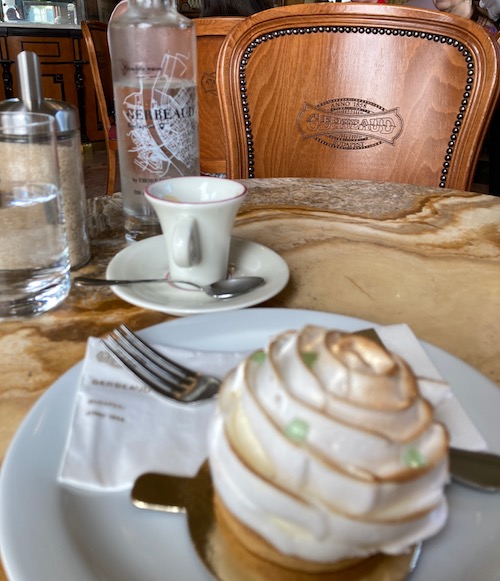

Nice to hear from you, Christina. I enjoyed delicious pastries from a bakery on a recent trip to Eugene, Oregon.
Great writing, so filled with delicate amusements:)